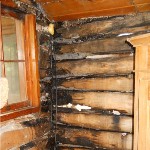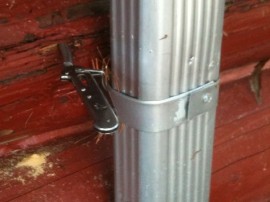Log homes: Important to keep your roof from leaking to prevent some expensive repairs down the road.
One common problem that we encounter in our inspections of log homes is leaky roofs or problems with water going where it does not belong. From the standpoint of protection of a log home or cabin, it is of utmost importance to keep the logs dry. This informs everything we do when it comes to maintaining log homes. Here are the areas to keep particular watch over in order to maintain a good roof system on a log home.



Give your home a check up around the upper roof areas, being sure to check:
1. Valleys that concentrate water into one area of the roof. If leaks develop here, these can quickly become major problems. It is important to note that water from a leaky roof does not always leak into the house. Sometimes it goes into the soffit (the area of roof outside the “house part”). These leaks can sometimes be hard to notice. If the under-side of your soffit or overhang is wet after a rainstorm, more investigation is necessary.
2. Places where lower roofline intersects with an upper log wall. There is a proper way to flash an upper log wall to a lower roofline. Click here for a drawing of the proper way to flash an upper log wall to a lower roof system.
3. Gutters that are failing for one reason or another can cause major problems. The gutters can be leaking at the seams, improperly pitched so that they are filling and overflowing each time it rains, or they are detached from the fascia altogether causing water to make its way onto the logs. Gutters need to be checked annually because the snow and ice can really reek havoc on them.
4. Lack of a drip edge can be problematic. Drip edge is the metal flashing that is attached to the edge of the roof to transition between the roof shingles and the wood or metal fascia. The drip edge prevents the water from following the fascia down the roof, but instead makes it “drip” from the “edge”… thus its name. We are surprised how many log homes we see that lack this important detail at the roofline. If you don’t have drip edge installed on your roof, ask a roofer to install it — you will be glad you did!
5. Another place that is common for roof leaks is around a chimney. First off, water could be leaking at the point where the flashing meets the roofline around the base of the chimney. Secondly, the masonry or rock itself could be cracked or improperly sealed, which allows it to soak up moisture. A third possibility is the lack of a properly installed chimney cap. A chimney cap is a cement slab poured on top of the existing masonry chimney. The cap acts as a roof for the chimney, keeping the majority of water off the chimney. It is also very important that the chimney be properly sealed around the mortar, stone or bricks to prevent leaking.
All these above features of a log home upper roofline should be inspected annually in order to keep your log home in good shape. A leaking roof, if allowed to persist, can cause some of the most complicated log replacements that we have seen in our 40 plus years in business. Bottom line: Keep up with roof inspections and have happy logs!